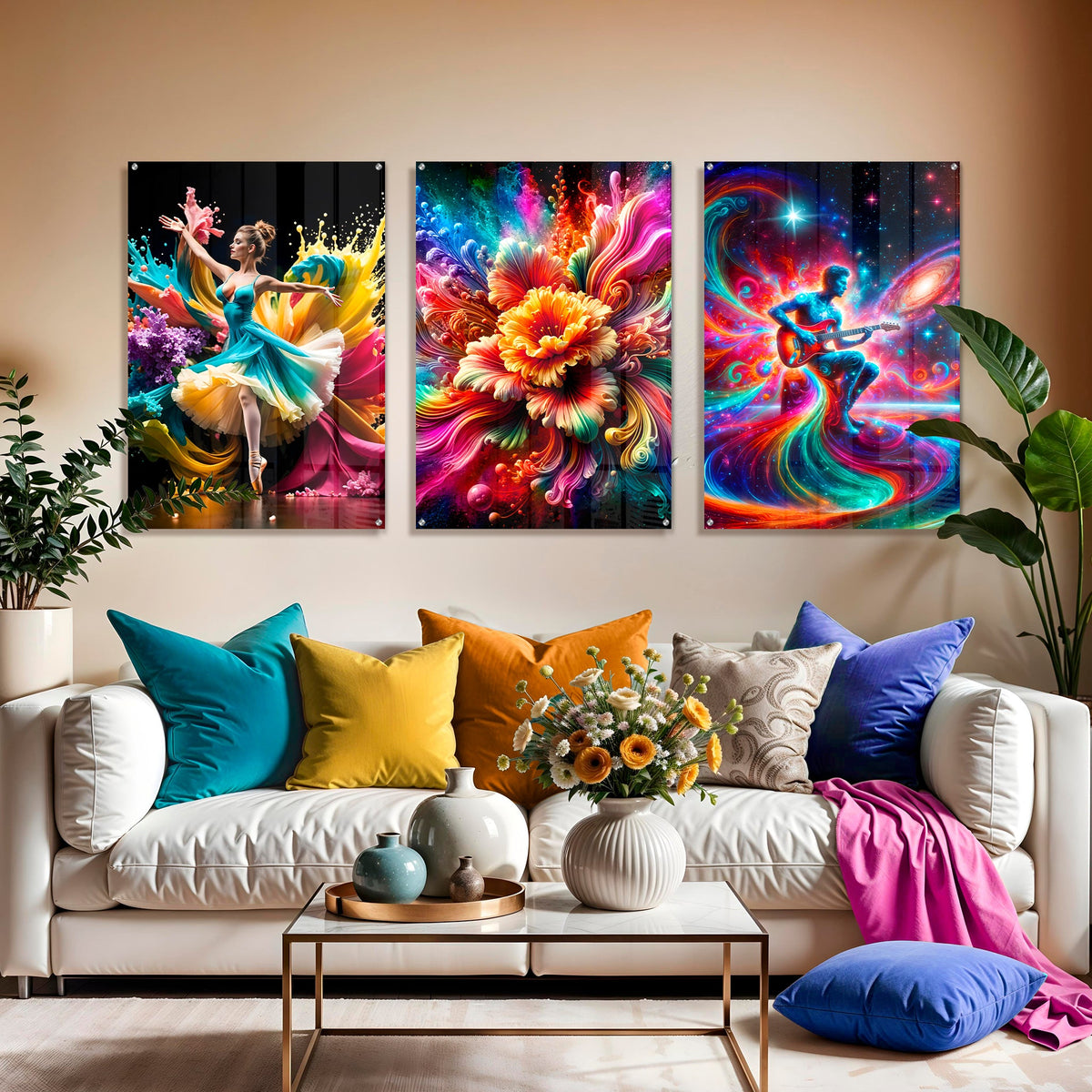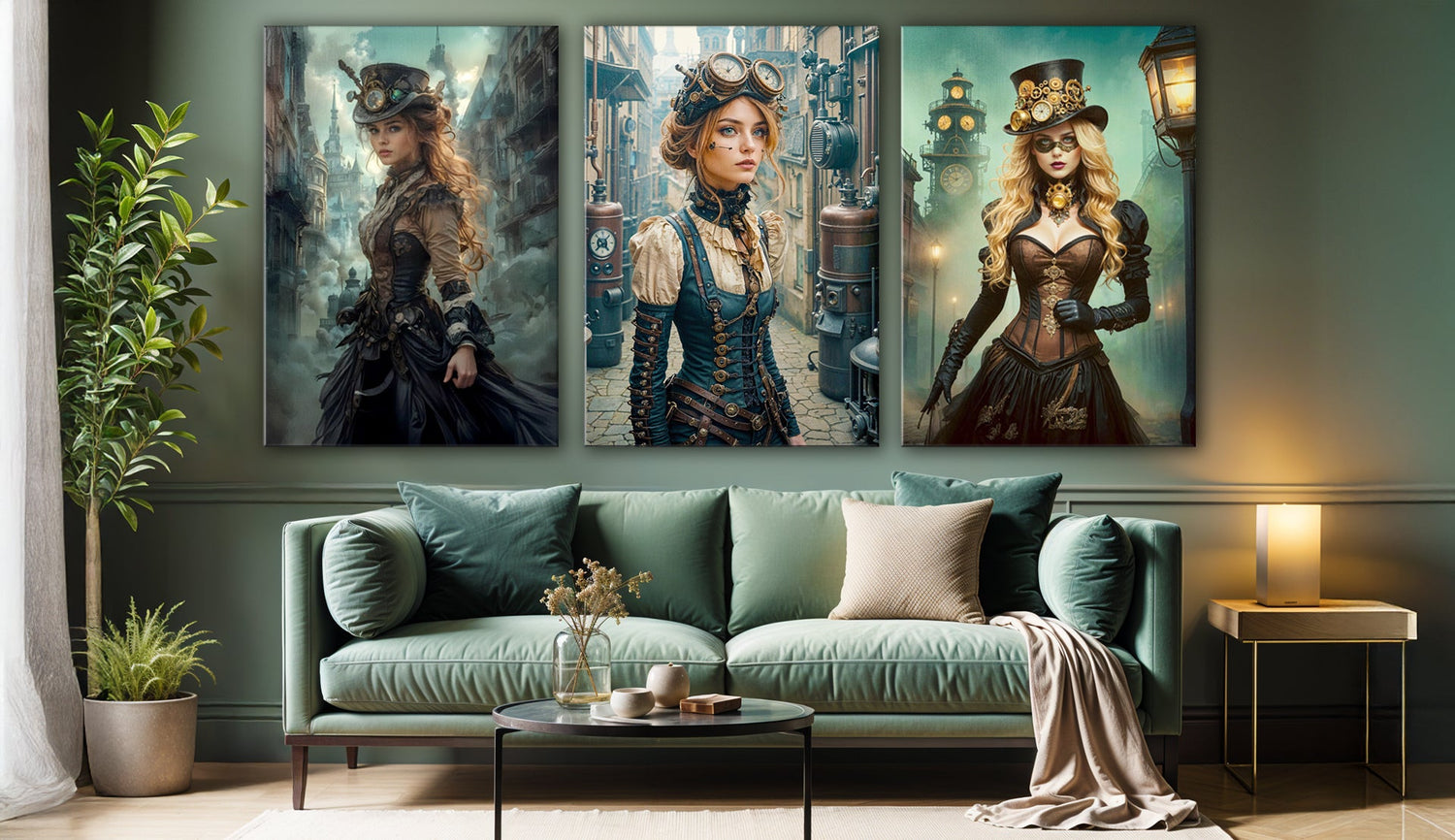
Movement, Bloom, and Sound: A Trio of Acrylic Prints That Refuse Stillness
There are certain walls in a home that feel empty, even when painted in the perfect shade or framed by beautiful furniture. It’s not the lack of objects that creates this silence, but the absence of mood. Art has a way of correcting that, of lending rhythm to spaces that otherwise remain static. This particular trio of acrylic prints—Vibrant Ballerina, Painted Flower, and Space Guitar—leans into that idea. They are not quiet pieces. They burst, stretch, and echo across their glossy surfaces, each one a reminder that movement doesn’t need to be limited to bodies or instruments.
When Three Very Different Stories Share a Wall
Taken separately, these works seem to belong to different worlds. The ballerina, dressed in turquoise with a skirt flaring into a blur of color, looks frozen mid-performance, her limbs as precise as her expression is serene. The flower, on the other hand, behaves more like a force of weather than a bloom, its petals curling outward as if painted in air. Then there’s the guitarist—part human, part constellation—immersed in a swirl of cosmic light as though sound itself could bend galaxies.
Placed side by side, the contrast is obvious. A dancer, a flower, a figure with a guitar in space. Some might argue that the subjects clash, that they are too different to share the same wall. Yet it appears that the clash is what makes them work. They are all about energy. They remind you that rhythm can come from the body, from the natural world, or from music that stretches far beyond earth.
The Gloss of Acrylic—Enhancement or Interruption?
Mediums alter how art behaves, and acrylic is not subtle. Its reflective surface brightens colors, making turquoise, magenta, and orange vibrate against one another. The ballerina’s skirt seems to shimmer as the day shifts, the flower glows like enamel, and the guitarist’s cosmic haze carries a liquid depth.
That shine is both a blessing and a burden. In bright rooms, it heightens presence, almost giving the illusion that the works are dimensional. But in dim corners or under a single lamp, reflections can be distracting, pulling attention away from the image itself. Critics of acrylic might say it risks feeling more decorative than painterly. Supporters, however, point out that it is precisely this intensity that keeps the prints from fading into the background.
From a practical standpoint, acrylic does what other mediums cannot. It resists humidity, making it plausible in kitchens or bathrooms where canvas or paper would warp. This practicality may not inspire poetry, but it does extend the life of the experience.
How They Alter a Room’s Atmosphere
Each of these works changes a space differently. The ballerina tends toward grace, giving a living room wall or even an entryway the sense of ceremony, as though every arrival or departure deserves a stage. The flower tilts toward warmth and abundance. Placed in a bedroom, it could soften shadows and create richness, especially against muted fabrics or dark woods. The guitarist, immersed in nebulae, is harder to place neatly. It seems best suited for an office or creative studio, where imagination benefits from an anchor that is both human and cosmic.
Together, the three create a dialogue that is less about similarity than about balance: precision against expansion, bloom against sound, and human scale against galactic scale.

Beyond the Straight Row
The default is to line them up, evenly spaced, across a sofa or bed. It works, but it risks taming their individuality. Consider instead a vertical arrangement—ballerina above, flower in the center, guitarist below—suggesting a cascade of rhythm from body to bloom to sound. A diagonal across a hallway could carry the eye forward, each print pulling you further. Or, for those willing to experiment, scattering them across different rooms turns the home itself into a gallery, the connection revealed not in sight but in memory.
Art does not need to behave like furniture, polite and balanced. Sometimes its purpose is to alter rhythm.
A Small Hypothetical Shift
Imagine a dining room painted in neutrals, with a polished oak table and upholstered chairs that do their job but don’t spark conversation. One evening, the Painted Flower is mounted on the wall. The next morning, light hits its curling petals, and suddenly meals feel less like routines and more like occasions. Guests pause, remarking not on the food but on the bloom that dominates the wall. The room hasn’t changed structurally, but its energy has shifted. That is how wall art works—it reshapes mood more than matter.
Where They Might Divide Opinion
It would be misleading to pretend these prints suit every taste. Minimalist interiors may find them overwhelming, too saturated, and too insistent. The ballerina risks feeling theatrical in small rooms. The flower could overpower spaces already rich in color. The guitarist leans heavily toward fantasy, which some might dismiss as escapist. Yet those very critiques highlight the value of the trio. They are not timid. They take up space, visually and emotionally. In the right home, that boldness is what gives them meaning.
Why the Trio Works Best as a Set
Individually, each of the three holds weight. But together they achieve something else: range. Movement, bloom, sound. Body, nature, cosmos. To live with them is to allow your walls to hold more than images—it is to let them echo different kinds of energy. A single piece might fill a wall; the set seems to fill a house with rhythm.
Closing Reflection
Homes can be complete without art, but they rarely feel alive. The Vibrant Ballerina, Painted Flower, and Space Guitar prints do not whisper or decorate politely. They challenge stillness, they heighten light, and they may unsettle minimalists. But in doing so, they create the possibility of rooms that breathe, rooms that carry rhythm even when silent.
If your walls feel too static, this trio won’t just complete them—it will move them.







